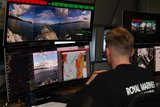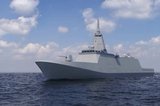SeaRAM completes test shots
Test shots have been successfully fired by the SeaRAM anti-ship missile defence system during a series of demonstrations by the US Navy, Raytheon announced on 17 May. The tests took place on the navy's Self Defense Test Ship off the Southern California coast.
During the demonstrations, scenarios representative of the current threats to naval ships were simulated, with SeaRAM successfully eliminating targets. Two shots were fired from the system, including one in which two simultaneous inbound supersonic missiles were flying evasive, complex manoeuvres.
In both flights, SeaRAM was able to detect, track and engage the threats, and fire Rolling Airframe Missile (RAM) Block 2 guided missiles to successfully intercept and eliminate the targets.
Rick Nelson, vice president of naval and area mission defense product line, Raytheon, said: 'SeaRAM achieved a new level of success today, intercepting targets under high-stress conditions. The system demonstrated once again that it can provide the sophisticated protection warfighters need.'
More from Naval Warfare
-
![NATO tests use of “undetectable, jam-proof” laser communication in maritime scenarios]()
NATO tests use of “undetectable, jam-proof” laser communication in maritime scenarios
As part of its effort to better prepare its capabilities for operations in contested and congested scenarios, NATO evaluated a Lithuanian ship-to-ship terminal designed to not be susceptible to enemy interference.
-
![US Navy advances with the Harpoon Service Life Extension Programme]()
US Navy advances with the Harpoon Service Life Extension Programme
The US Navy plans to improve Harpoon’s anti-ship and land attack capabilities by equipping the missiles with sensors and technologies required for succeeding in future battlespace.
-
![Mitsubishi eyes future with Australia’s Mogami selection]()
Mitsubishi eyes future with Australia’s Mogami selection
With Australia’s selection of the Mogami-class for Project Sea 3000, Mitsubishi is investigating local production in the next decade as potential export opportunities emerge.
-
![Thales’ new Sonar 76Nano could equip UK Royal Navy on anti-submarine warfare missions]()
Thales’ new Sonar 76Nano could equip UK Royal Navy on anti-submarine warfare missions
The new sonar is designed to equip uncrewed underwater vessels, with the potential to be used by the Royal Navy for its Atlantic Bastion and Atlantic Net missions.
-
![Hanwha wins Australian government approval to increase its stake in Austal]()
Hanwha wins Australian government approval to increase its stake in Austal
The contract would mean the two shipbuilders can collaborate strategically and enhance shipbuilding capabilities in Western Australia.























